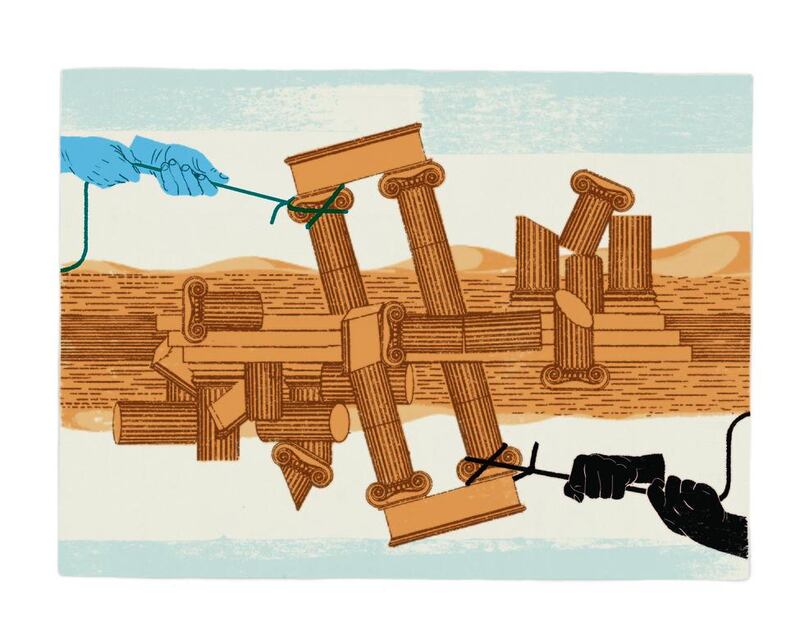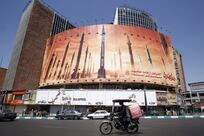Archaeology has long been used as a weapon to advance political agendas. In a region with such a fascinating past, it is depressing how archaeological practice has become part and parcel of Israel’s continuing military strategy to attain additional Palestinian territory. Now a new exhibition in Dubai is exploring this pressing issue, by subverting it.
Since Israel’s occupation of the West Bank and Gaza in 1967, countless artefacts have been unearthed and removed by state-sponsored archaeologists and freelance raiders, often for the wrong reasons.
Among the most serious crimes in the archaeological hall of shame are the exploits of General Moshe Dayan, a stealthy tomb-raider and high-ranking politician who gained notoriety for engaging in uncontrolled robbery digs, often under the guise of military missions.
He and his hired bandits are known to have expropriated a plethora of artefacts; many of his prized collections were stockpiled at his home; some were peddled on the black market to counterpart international dealers. Others were later sold to the Israel Museum, including anthropomorphic coffins from Dir Al Balah in the Gaza Strip and a stone mask from the Neolithic period, now exhibited for public display.
The strategic use of archaeology as a state-building tool was latched onto by the founding prime minister of the state of Israel, David Ben-Gurion. He realised that correlating a particular vision of Jewish genealogy with Biblical accounts would serve to legitimise the grand objective of securing what is seen as the promised land.
The stories of the exodus, the conquest of Canaan, the kingdoms of Saul, David and Solomon were simply fuel for the Zionist claim to Palestine, thus Ben-Gurion hurried the search for archaeological proof.
Archaeological digging that is ideologically driven has proved to be quite instrumental in rewriting the history of Jerusalem in line with expansion plans of right-wing Jewish settler movements. One such movement, Elad, have been exposed for manipulating manufactured narratives to out-trump legal claims of Arab landowners facing eviction in the Palestinian district of Silwan, located just below the ancient City of David.
What’s also problematic, as pointed out by Israeli archaeologist Rafi Greenburg and other critics, is that the religious authorities who control the serpentine Western Wall tunnel located under buildings of the Old City of Jerusalem will only cooperate with excavations that support their historic narrative even if the archaeological evidence suggests something different.
The relationship between fact and fiction is inextricably interlinked. Like many nations (yes, other nations do this too), Israel thrives on the business of nation-building based on narrative grounds, even if it means shoehorning historical narratives to fit mythical notions of nationhood. The surrealism of this current reality is far more bizarre than any author of fantastical fiction could endeavour to imagine. Or is it?
Whilst many of us have become inadvertently desensitised by the dystopian deadlock between Palestine and Israel, recent thought-experiments by the Jerusalem-born artist Larissa Sansour have the potential to shake audiences out of zombie states of paralysis by prompting them to re-examine the status-quo from an alternative parallel dimension.
Sansour’s ethnographic insights have propelled her to become an erudite technician of using science fiction as a distorting mirror to create “philosophical playgrounds” for us to explore.
In Nation Estate (2012), Sansour postulates a vertical solution to Palestine’s diminishing claim to land: future citizens reside in a single colossal skyscraper with each floor embodying a Palestinian city.
No need for illegal apartheid walls here: people can simply hop between cities via a lift. Residents literally experience the high life while dwelling in a sterile environment of cutting-edge technology, roaming in sophisticated attire and dine using the finest porcelain.
This symbolic tableware became the catalyst behind Sansour’s latest film, co-directed with Søren Lind, now being screened as part of a new exhibition at the Lawrie Shabibi gallery in Dubai.
In the Future They Ate from the Finest Porcelain is a timely parody of the politicised archaeology carried out in present day Israel/Palestine.
A futuristic resistance group sets out to embed a historical myth to support future claims to their vanishing lands. Their tactic is to deploy a fleet of bulging spacecraft to bury ornate saucer-shaped porcelain deep into the Earth for subsequent excavation; the archaeologists who subsequently unearth these artefacts will be unwittingly primed to perpetuate the myth that these salvaged relics supposedly belonged to a lost ancient civilisation of high-tech Palestinians.
The future that Lind and Sansour are visualising may seem absurd, yet it has roots in very real political situations that exist in the present day – where counterfeit narratives are being used to mould national identity. For viewers, the intended conclusion is clear: the longer a myth persists, further down the line, someone will inevitably document it as a fact.
There are some disturbing parallels between Israel’s politicisation of archaeology and the divisive tactics being used to advance the agendas of extremist cults.
In the same vein that archaeology is used as a tool for nation-building, a proven formula for nation-breaking is the deliberate destruction of significant archaeological remains. We are seeing ISIL do that in Iraq and Syria, as we see groups like Elad do it to Islamic archaeological sites in Israel. In both cases, it is motivated by a perverted religious zeal.
ISIL is trading stolen antiquities to clandestine professional dealers, while licensed gift shops in Jerusalem are openly selling looted artefacts as memorabilia to pilgrims, tourists and collectors alike. These peculiar microcosms are two sides of the same coin – symptomatic of a much deeper issue that we all have a stake in.
When nations lose access to their universal material cultural heritage, they become unrooted, void and easier to supplant. What makes the loss of archaeological remains a universal catastrophe? When objects are deliberately decontextualised and scattered from their true provenance without proper care or attribution, the interconnecting narrative of our entire civilisation becomes fractured.
For archaeologists working in the distant future it could be like trying to piece together a shattered mosaic of missing fragments.
Archaeology informs our collective memory, which is fundamental in shaping our identity as individuals. If our collective memory continues to be adulterated and stripped away, we all risk losing a sense of ourselves. We will be unable to appreciate who we really are. Not only to properly understand where we came from, but to also get a grip on where we are going.
Yasmin Khan is the producer of Sindbad Sci-Fi. In the Future They Ate from the Finest Porcelain is showing at the Lawrie Shabibi Gallery in Dubai until March 3
On Twitter: @Ya5min_BL





